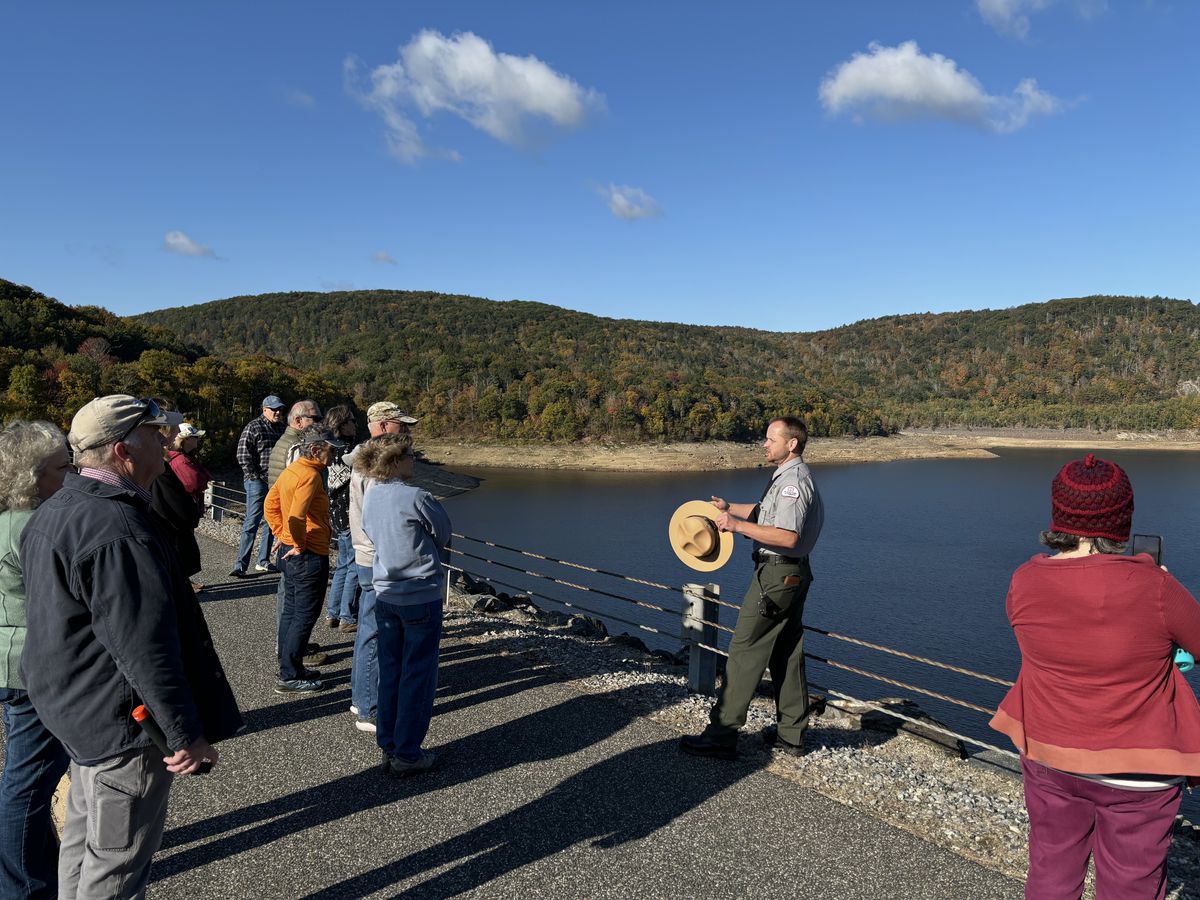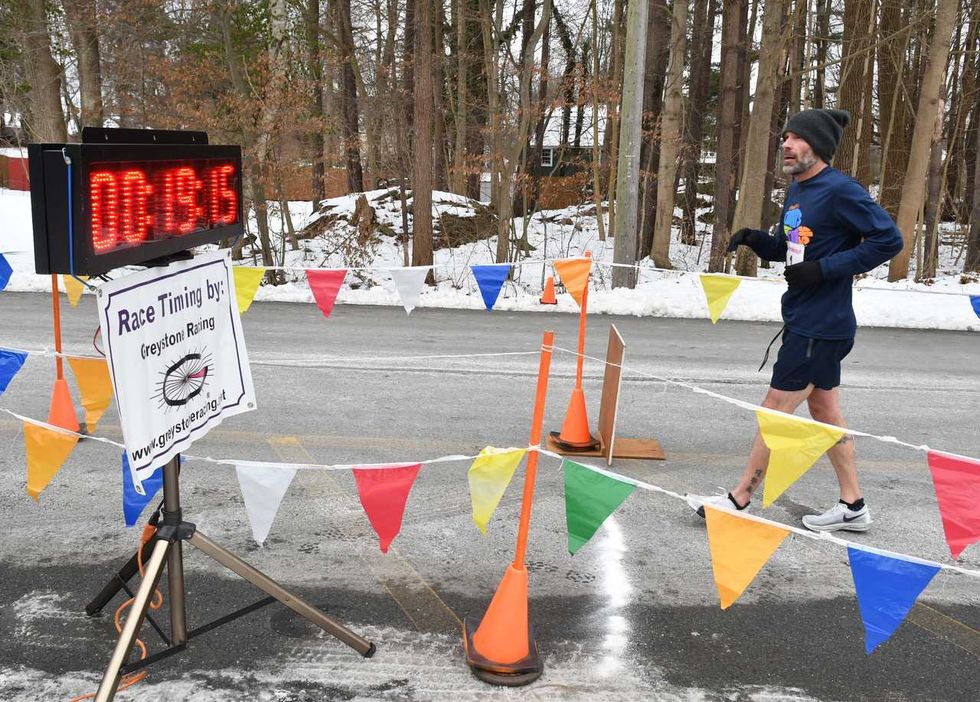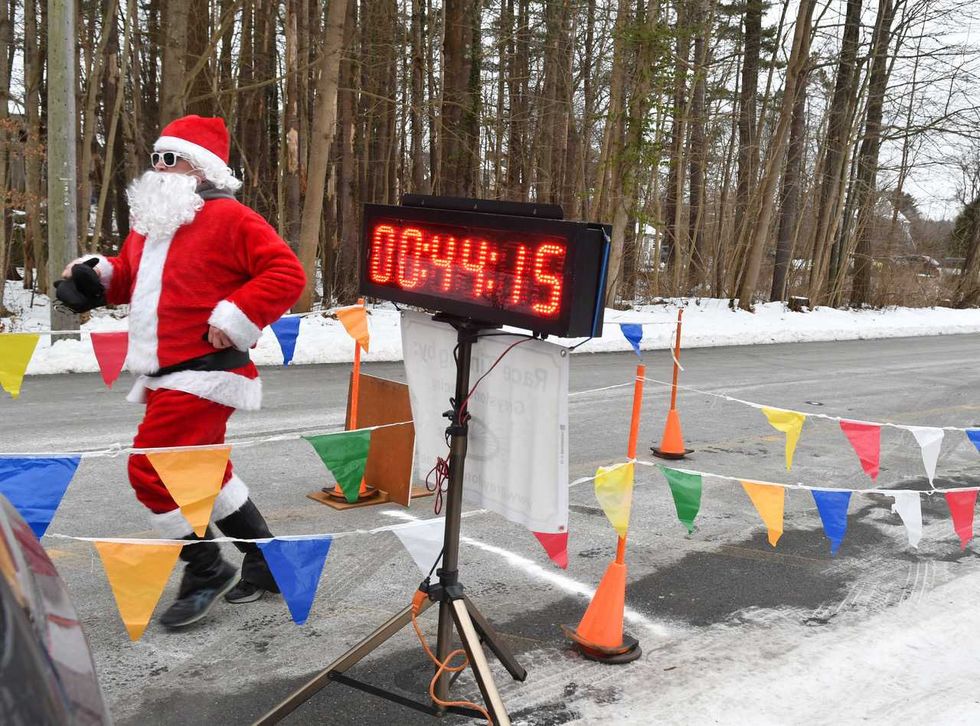Dam walk yields views and warnings

Natural Resource Specialist James Jylkka explains the mechanics of the dam.
Alec Linden

Natural Resource Specialist James Jylkka explains the mechanics of the dam.
COLEBROOK — A dozen or so people ambled across the concrete and stone behemoth of the Colebrook River Dam under a crisp autumn sky on the morning of Saturday, Oct. 5 while a bald eagle circled overhead, occasionally divebombed by an angry avian neighbor. It was one of the final Housatonic Heritage Walks of the season, and the topic was floods.
“As a Corps, we’ve gotten away from saying flood prevention because it’s just not realistic to prevent floods,” said Natural Resource Specialist James Jylkka of the U.S. Army Corps of Engineers, New England District. He clarified that the Corps uses the terms “flood risk management” or “flood mitigation” because, as Jylkka said, “If there’s a major event like there was in ’55, there’s going to be damage downstream.”
The event in question was the quick succession of two hurricanes, Connie and Diane, in August of 1955 which devastated interior New England, especially Northwest Connecticut. According to the National Weather Service (NWS), the event was so destructive because the first storm, Connie, saturated the ground, which Diane then dumped up to 20 inches of rain on top of a week later. It was a very similar set up to that which caused the catastrophic flooding in the Southeast from Hurricane Helene in September.
According to the NWS, Connecticut suffered the biggest losses from that event in New England, with 77 lives lost and over 350 million dollars in property damage. Matthew Coleman, operations manager of the Naugatuck River Basin with the Corps, maintained that major flooding from large hurricanes during the 1930s and 1950s was the major impetus behind the Corps reservoir program in New England. Coleman and Jylkka confirmed that the Colebrook River Dam, which stops up Colebrook River Lake (and hides the now-submerged lost village of Colebrook River), was built as a result of the 1955 floods. The dam was finished in 1969.
Jylkka was careful to point out that floods and storms are contextual. The dam regulates its water level throughout the year – on the day of the outing, the water was quite low, which is typical Jylkka said – and so if a storm like 1955’s that arrived in fall when the water was low, it might not have such disastrous impacts. Should it arrive in spring with high water, it could be devastating.
“It doesn’t take a major hurricane to cause this devastation,” he said, referring to the events of 1955. “It’s site specific and context specific.”
An example of this was the flooding along the Little River in August which claimed three lives and wreaked havoc upon the town of Oxford and downstream municipalities. The flooding resulted not from a hurricane, but from a series of slow moving, drenching thunderstorms that dropped enough precipitation that many thought the storms might have overtaken Diane’s current record for 24-hour rainfall. After review, Diane still holds the record, but the damage from the storms remains — Route 34 in Oxford only reopened on Oct. 16, nearly two months after the floods.
Coleman said that the stretch of river which flooded in August is not under the Corps’ management – on that day, “our reservoirs did do their jobs.” However, Jylkka maintained that waterways are complex systems, and many watersheds are not under the Corps’ management. Many reservoirs are managed by drinking water firms who like to keep the reservoirs full, thus making them flood prone, Jylkka said. Even flooding in Vermont could have impacts in the Northwest Corner, he said.
For their part, the Corps has “a laundry list of stringent requirements” that keep their watersheds very well managed, Jylkka said. Coleman assured that the Corps has “a whole team of professionals on the ground in the New England District,” both doing boots on the ground maintenance and operation alongside a team of engineers monitoring weather and flow conditions.
As climate change brings wetter and wilder storms to the region, Jylkka suggested that residents “be smart and be prepared – It is more critical than ever for people to be aware of their surroundings.”
Housatonic Valley Regional High School, where the price of school lunch will increase to $4.00 beginning Jan. 5.
FALLS VILLAGE -- School lunch prices will increase at select schools in Regional School District No. 1 beginning Jan. 5, 2026, following a deficit in the district’s food service account and rising food costs tied to federal meal compliance requirements.
District officials announced the changes in a letter to families dated Monday, Dec. 15, signed by Superintendent Melony Brady-Shanley and Business Manager Samuel J. Herrick
Under the new pricing, lunches at Lee H. Kellogg School and Cornwall Consolidated School will increase by 25 cents to $3.75, while lunches at Housatonic Valley Regional High School will rise by 50 cents to $4.00.
According to the district, the food service program depends on revenue from lunch sales as well as federal reimbursement. Increased food costs and compliance requirements contributed to the shortfall during the 2024–2025 fiscal year.
School lunch prices have remained unchanged since the 2019–2020 school year, prior to the COVID-19 pandemic. In the years that followed, the district used COVID-19 relief funds to allow students to receive lunches at no cost.
Families who believe they may qualify for free or reduced-price lunch may apply at any time during the school year. Applications are available online for Housatonic Valley Regional High School, Lee H. Kellogg School and Cornwall Consolidated School.
The lunch price increase applies only to these three District No. 1 schools, as Housatonic Valley Regional High School oversees the food service programs at Lee H. Kellogg School and Cornwall Consolidated School. Other schools in the district operate independent food service programs and are not affected.
Runners line up at the starting line alongside Santa before the start of the 5th Annual North Canaan Santa Chase 5K on Saturday, Dec. 13.
NORTH CANAAN — Forty-eight runners braved frigid temperatures to participate in the 5th Annual North Canaan Santa Chase 5K Road Race on Saturday, Dec. 13.
Michael Mills, 45, of Goshen, led the pack with a time of 19 minutes, 15-seconds, averaging a 6:12-per-mile pace. Mills won the race for the third time and said he stays in shape by running with his daughter, a freshman at Lakeview High School in Litchfield.

Don Green, 64, of Red Hook, New York, was second among male runners with a time of 21:17 and a 6:52-per-mile pace. Becky Wilkinson, 47, of Southfield, Massachusetts, was the first woman to cross the finish line with a time of 22:16, averaging a 7:11-per-mile pace. Wilkinson finished fourth overall.
Margaret Banker, 52, of Lakeville, finished second among women runners with a time of 23:59 and a 7:44-per-mile pace.
Runners came from all over Connecticut, Massachusetts and New York. One runner listed home as London, England. Many were members of the Run 169 Towns Society, a group that is dedicated to completing races in every one of Connecticut’s 169 towns. Elizabeth Smith, 32, of Manchester, a member of Run 169, said this was her 162nd town.
“I started 10 years ago,” Smith said. Her husband, Daniel, 33, has run races in 73 Connecticut towns, now including North Canaan. He was eager to know where to get a good cup of coffee after the race.
Santa, who got a head start on the group of runners but finished next to last with a time of 44:14, has been a feature in the North Canaan race since it started five years ago.
The 5K proceeds from a start in front of the North Canaan Elementary School on Pease Street to course around the Town Hall parking lot, up West Main Street past the transfer station to the state line and back. Cheryl Ambrosi, 45, of Danbury, was the last to cross the finish line with her dog Benji. “It was so much fun,” she said as she ended, even though she didn’t catch Santa.

The Torrington Transfer Station, where the Northwest Resource Recovery Authority plans to expand operations using a $350,000 state grant.
TORRINGTON — The Northwest Resource Recovery Authority, a public entity formed this year to preserve municipal control over trash and recycling services in northwest Connecticut, has been awarded $350,000 in grant funds to develop and expand its operations.
The funding comes from the Department of Energy and Environmental Protection via its Sustainable Materials Management grant program. It is intended to help the NRRA establish operations at the Torrington Transfer Station as well as support regional education, transportation, hauler registration and partnerships with other authorities.
Founded by the City of Torrington in May 2025, the NRRA was established to oversee regional municipal solid waste management. Its creation followed a $3.25 million offer by USA Waste & Recycling to purchase the Torrington Transfer Station — a sale that would have privatized trash services in the region.
The proposed sale was initially approved by the MIRA Dissolution Authority, the entity responsible for dissolving the state’s former Materials Innovation and Recycling Authority, which owned the Transfer Station at the time. Before the transaction could close, the state intervened and directed that the facility’s operating permit be assigned to the NRRA to preserve a publicly controlled alternative.
MIRA has since dissolved, and the Transfer Station is currently operated by the state Department of Administrative Services. Many towns in northwest Connecticut have expressed interest in joining the NRRA. As of December, Torrington and Goshen were the only two municipalities in the authority.
At the Dec. 11 meeting of the Northwest Hills Council of Governments (COG) — a regional planning body representing 21 municipalities in northwest Connecticut — Director of Community and Economic Development Rista Malanca encouraged more towns to sign on.
“We need towns to join the Northwest Resource Recovery Authority to show your support, show this is what you want to do,” Malanca said.
Salisbury First Selectman Curtis Rand said his municipality is planning a town meeting in January to vote on a resolution to join the NRRA. Cornwall’s Board of Selectmen recently discussed scheduling a town meeting in the winter for the same purpose. Sharon, Falls Village and North Canaan have also expressed continued interest in pursuing a public option.
Kent is the northernmost member of the Housatonic Resource Recovery Authority, a regional solid waste authority representing 14 municipalities stretching south to Ridgefield. COG towns expressed interest in joining HRRA in 2024, but they were denied and set out to develop the NRRA.
“We also have been having conversations with the Capital Region Council of Governments and the Naugatuck Valley Council of Governments to think about how we can use existing resources, maybe some of these grant funds, to bring in shared resources or shared staffing that will help with some of the recycling coordinating efforts,” Malanca said.
With grant funds secured, NRRA aims to grow to a point that it can take over operations at Torrington Transfer Station to serve as a regional hauling hub. What happens to the trash after that has yet to be determined. Currently, it is being shipped to a landfill out of state. The existing municipal refuse hauling contracts that were established with the state expire in 2027.
The Salisbury Winter Sports Association (SWSA) will host its annual Junior Jump Camp, a two-day introduction to ski jumping, on Saturday and Sunday, Dec. 27 and 28, from 9 a.m. to 2 p.m. at Satre Hill in Salisbury.
The camp is open to children ages 7 and up and focuses on teaching the basics of ski jumping, with an emphasis on safety, balance and control, using SWSA’s smallest hill. No prior experience is required.
The cost is $50 per child and includes instruction and lunch on both days. For more information or to register, visit www.skireg.com/swsa-camp or email info@jumpfest.org